Update on Biological Control and the Challenges Growers Face
by Michael P. Parrella and Edwin Lewis
Biological control is employed as an integral component of IPM programs in commercial ornamental production. Given the current emphasis on sustainable production systems, one would expect that the use of biological control in greenhouses and nurseries would be increasing. However, there is concern that this is not the case. Here, we explore the advantages of biological control and the challenges growers must overcome in implementing and maintaining a successful program. We also present the current status of natural enemies for controlling important pests in floriculture and nursery production.
Factors Favoring the Use of Biological Control
Biological control uses living organisms to reduce pest populations. Because biological control reduces pesticide use, is highly selective, and is self-perpetuating, there are several major advantages, as described below. Moreover, an entire industry has developed to produce, disseminate, and aid in the adoption of natural enemies.
Reduces pesticide use. When biological control is implemented into an IPM program there is less reliance on pesticides for managing pest populations. This may help address problems with pesticide resistance and lessen the negative impact on overall plant quality that can occur with repeated applications of pesticides. Biological control may also be a simpler option for growers facing increasing rules and regulations governing pesticide use.
Fits into sustainable/organic practices. Biological control is a highly selective control measure that is considered an important technology for sustainable agriculture because it minimizes the negative impact on the environment and improves workers safety while maintaining the economic viability of crop production. There is a general movement in the ornamental production industry toward sustainability promulgated by consumers of plant products and a new generation of growers who are more concerned about pesticide use and its potential non-target effects than previous generations. Third-party certification of sustainable practices (e.g., GLOBAL G.A.P.) is required by some retailers of ornamental crops due to increased demand for safe, eco-friendly products.
Cost effective. Studies comparing costs in the greenhouse/nursery are limited but have shown that biological control is cost competitive — especially compared to the cost of some of the newer pesticides — and can be as effective as chemical control. Moreover, in some cases, products grown using biological control under sustainable/organic practices command a higher price. Advances in the use of banker plants and new mechanical applicators for natural enemy release have the potential to make biological control even more self-perpetuating and economical. A year-round production system can be implemented to permit natural enemies to establish and move from crop to crop, which also reduces costs.
Natural enemies and support services are widely available. It is estimated that there are over 200 commercially available natural enemies used for biological control, and the number of biopesticide products are increasing. Although few natural enemies are sold through mainstream suppliers of agricultural products that are convenient for one-stop shopping, they are readily available from distributors that specialize in supplying natural enemies and from insectaries. Research and support from the university/cooperative extension has been reduced due to budget costs and limited grant support, but private consultants employed by commercial insectaries regularly visit growers. They have been instrumental in increasing adoption and moving biological control forward in this industry.
Biological Control Challenges
Despite the advantages, the use of biological control in ornamental crops in the United States and Europe is limited and is not increasing. Some of the factors listed in this section have made biological control in floriculture and nursery crops more complicated than for other commodities. There are many hurdles growers must surmount to make biological control work.
Aesthetics. Floriculture and nursery products are grown almost exclusively for aesthetic value and must be of very high quality (few pests and/or their damage) when the crop goes to market. Even incidental pests that pose little threat to the crop and/or the presence of natural enemies may cause retailers to reject a shipment.
Invasive Species. The intense use of pesticides needed to satisfy quarantine requirements for invasive species creates an environment that is also lethal to arthropod natural enemies. In addition, growers who must spend sizable amounts on insecticide treatments to meet quarantine requirements are less likely to spend more money on biological control agents. To date, no natural enemies have been approved for meeting quarantine requirements for any invasive pest in the United States. With a new invasive pest every 60 days in California, and with plant material moving within the state and across the country, the quarantine requirements are more restrictive than almost anywhere else in the world. Additionally, restrictions governing the international movement of natural enemies has limited the number of new natural enemies that can be used in biological control programs.
Large number of crop groups and cultivars. Many different groups of ornamental crops are produced (e.g., bedding plants, cut flowers, seed production, foliage plants), and most nurseries produce many species and/or cultivars of plants. Pests and their natural enemies may each have specific responses to different plants or cultivars, and their interactions become more complicated as the diversity of plants increases. Recommendations must be tailored for each crop grouping and for specific crops. For example, in general, biological control on short-term crops such as bedding plants is more difficult because biological control agents rarely work as fast as chemicals.
Pest complex includes multiple pest species. Multiple pests attack the many different crops typically grown in nurseries. Growers who specialize in a specific crop frequently manage multiple pests that attack their crop simultaneously. The more pests that must be controlled with biological agents, the more difficult it becomes because several different species of natural enemies must be released, significantly increasing costs (as opposed to one broad-spectrum pesticide that may kill all pests after one spray). Multiple natural enemies may interfere with one another through competition and/or intraguild predation.
Pesticides may not be compatible. For destructive pests in the pest complex that cannot be controlled with natural enemies (e.g., Lygus spp.) there is little choice but to use pesticides and these generally disrupt biological control. Broad-spectrum pesticides with long residual toxicity are especially harmful to natural enemies. However, some of the newer, more specific pesticides (i.e., insect growth regulators; entomopathogens) and pesticides with short residual toxicity have the potential to integrate effectively with the use of natural enemies. (Editor’s note: see UC IPM Pest Management Guidelines for Biological Control Table 1 for a list of compatible pesticides).
Natural enemies may be adversely affected by environmental conditions. Temperature affects the development of arthropod biocontrol agents and can limit their activity. Short day length can limit the efficiency of visual predators. Many beneficial species stop reproducing under short day length or prolonged cool conditions (e.g., Aphidoletes aphidimyza) and cannot be used at certain times of the year without supplemental light and/or heating.
Pest migration into the greenhouse/nursery. When an agricultural field is harvested near a greenhouse or nursery, a surge of pests often moves into the ornamental crops. Such a large influx is hard to manage with biological control, even with advanced warning/monitoring systems in place. However, nurseries that produce crops in greenhouses can screen them to prevent immigration of pests.
Biological Control of Important Pests
In this section, we describe the present status of biological control of some of the most important pests of ornamental crops grown in commercial greenhouses, flower fields, and nurseries.
Table 1 summarizes the natural enemies that have a proven track record in providing control efficacy or have research that supports their use.
Aphids
Hymenopteran parasitoids. The genus Aphidius contains many species that provide biological control of aphids (fig. 1). A. colemani appears to be the most effective of commercially available species, although limited research on biological control of aphids has been done in ornamental crops. This parasitoid can attack a wide range of aphid species and is capable of dispersing across a floriculture greenhouse in search of prey. For this reason, it is often the parasitoid of choice to use in a banker plant system, although hyperparasitoids can disrupt control. (Editor’s note: banker plant maintenance, aphid density, and banker plant rate are also important factors affecting aphid control using A. colemani banker plants; see van Driesche et al. 2008).
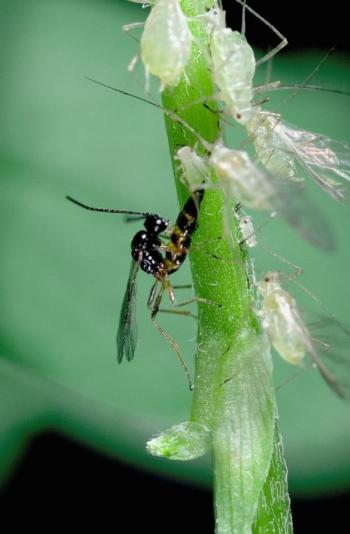
Predators. Several predators are available commercially or naturally migrate into ornamental crops (e.g., the predatory midge Aphidoletes aphidimyza, ladybeetles, minute pirate bugs, and hover flies). However, few growers of ornamental crops make use of any of these predators in formal programs of aphid control because a high population of aphids develops on the plants prior to successful biological control, and the resulting cast skins and honeydew are unacceptable. The use of lacewings in biological control programs in the greenhouse and nursery is limited and few scientific studies have documented their success on ornamental crops.
Entomopathogenic fungi. Isaria (=Paecilomyces) fumosoroseus, is a microbial insecticide sold under the name PFR-97 20% WDG. This product is registered for all greenhouse ornamental plants to control aphids and several other arthropods. Beauveria bassiana can also be used (see whiteflies).
Caterpillar Pests
Parasitoids, including tachinid flies and parasitic wasps, attack moth larvae and eggs of pest species (e.g., beet armyworm, yellowstriped army worm, variegated cutworm, light brown apple moth, European pepper moth). Although they reduce pest populations, larval parasitoids do not kill their hosts immediately; thus parasitized larvae may continue to feed through the last instar and may still damage crops. Applications of Bacillus thuringiensis (Bt) products (fig. 2) to control caterpillar pests will not harm parasitoids. Although it is an invasive pest species in California, requiring that plant material be completely clean when shipped, the European pepper moth (Duponchelia. Fovealis) has been effectively controlled using Steinernema. carpocapsae in the Netherlands. Generalist predators that are commercially available, such as the soil-dwelling predatory mite Hypoaspis (=Stratiolaelaps) miles and the rove beetle Atheta coriaria, have also been effective in controlling this pest. Thus these natural enemies could possibly be effective on other caterpillar pests that are not invasive species in greenhouses and nurseries.
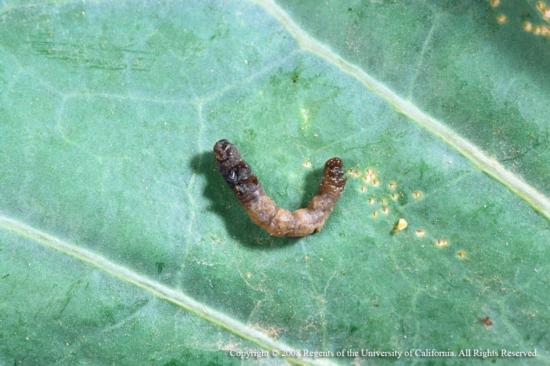
Fungus Gnats, Shore Flies, and Moth Flies
To control infestations of fungus gnats in greenhouses, commercial insectaries generally recommend the use of multiple natural enemies (bacteria, EPNs, predatory mites, and predatory beetles), presumably because no single species can provide acceptable control.
Predatory mites. Hypoaspis miles can provide good control of fungus gnat larvae (fig. 3). In more long-term crops, only an inoculative release of these predators is needed because they will reproduce and continue to build up in the crop. Many growers release this mite on a prophylactic basis, knowing it will establish in the soil and build up populations before pests become a problem in the crop. These predators do not impact shore flies and moth flies because of the aquatic/semi-aquatic environment in which these pests live.
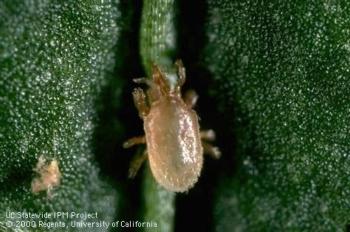
Predatory insects. Rove beetle adults, Atheta coriaria, are commercially available, but they are rarely used, probably because of the limited amount of data supporting their performance. There is some concern over whether this predator can be used successfully with predatory mites because it will eat them, but the two are often recommended for use together. At greenhouse temperatures, both A. coriaria and H. miles take 18–20 days to develop from egg to adult, and the adult beetles are relatively long-lived, surviving for months in the greenhouse. The hunter fly, Coenosia attenuata, has moved into many greenhouses (where pesticide sprays are reduced), and they can be seen aggressively feeding on fungus gnat or shore fly adults. (Editor’s note: the hunter fly is not commercially available. See Wainwright-Evans 2009 for more information about this common native predator.)
Entomopathogenic nematodes. EPNs also successfully control fungus gnats, but they
are not very effective against shore flies and have not been tested against moth flies. The advantage of EPNs is that they reproduce by infecting fungus gnats. Thus they can become established in greenhouses and provide control over fairly long periods; also, they are transported by adult flies from one pot to another. The most effective species is Steinernema feltiae, probably because it is a better foraging nematode than S. carpocapsae.
Microbial insecticides. Bacillus thuringiensis subspecies israelensis, which is available commercially, will control all these pests because it is toxic to most Diptera. Several trials have shown acceptable levels of control when the material is applied as a drench to pots.
Leafminers
Hymenopteran parasitoids. Diglyphus spp. wasps (fig. 4) are natural enemies that can be used to manage leafminer species within the genus Liriomyza. Growers who produce gerbera cut flowers commonly use D. isaea for leafminer control. Initially released when the plants are young and when leafminers are first observed, this natural enemy gradually builds up and can provide control through the life of this two-year crop. Because D. isaea is expensive (see example of Diglyphus costs), growers routinely collect these parasitoids once the numbers build up in the crop with a small vacuum and move them into adjacent crops. D. isaea is generally considered to be more effective in warmer greenhouse conditions, so it is often recommended that they be supplemented with the release of Dacnusa sibirica during the winter. Biological control of leafminers in gerbera can be disrupted by pests such as Lygus bugs, broad mites, and mealybugs that can require the application of pesticides to prevent crop damage.
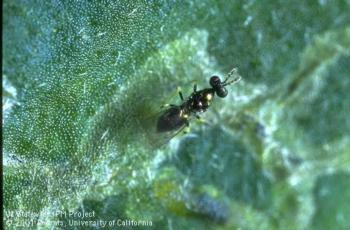
Entomopathogenic nematodes. EPNs such as Steinernema feltiae have the advantage of being able to infect the insects while they are inside the leaves, and there is evidence that they may be compatible with parasitoids, but their poor survival on the surface of leaves limits their effectiveness. Efforts are ongoing to formulate nematodes in a way that protects them from desiccation and other adverse environmental effects. This may improve their performance, especially in greenhouses, where the relative humidity is usually high.
Thrips
Hymenopteran parasitoids. The commercially available parasitoid Thripobius semiluteus is specific to the greenhouse thrips and can be an effective biological control agent (fig. 7). Given the gregarious nature of this thrips and its regular use of copious amounts of anal fluid in defense against predation and parasitism, few other natural enemies can provide effective control.
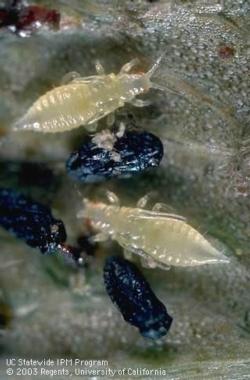
Predatory mites. Several predator species, including Amblyseius swirskii, Neoseiulus (=Amblyseius) cucumeris and Hypoaspis miles, can attack and kill western flower thrips (H. miles feeds on thrips pupae that drop from the plant to the soil). However, the western flower thrips uses anal fluid defensively, and this can be a good deterrent against predatory mites. Thus large numbers of predatory mites must be present on the plant so that they can overcome larger thrips by the simultaneous attack of two or more mites on each thrips. This can be accomplished by releasing these mites in sachets (see photo of sachet) and allowing the predators to move onto plants over time. When there are few options for thrips control, growers may use one sachet per plant, which will guarantee large numbers for thrips control. Mini-sachets have been developed to try to keep costs down when using this technique.
Predatory insects. Orius spp. (minute pirate bug), which are available commercially, are rarely used in floriculture/nursery, primarily because they are unable to keep thrips numbers low enough to satisfy aesthetic demands.
Entomopathogens. EPNs in the genus Heterorhabditis have been used to control western flower thrips with mixed results. They are applied to the potting medium at a high rate (400 per cm2) to infect the pre-pupal and pupal stages of the thrips. Even at this application rate, which makes the nematodes very expensive, they seldom cause more than 50% mortality. Combinations of predatory mites and nematodes can achieve greater control of thrips. The presence of mites on the plant cause more second instar thrips to fall to the soil to pupate, where they are susceptible to nematode attack. The use of the entomopathogenic fungus Beauveria bassiana (see whiteflies) has also been successful when thrips populations are low
.
Weevils
Entomopathogens. EPNs have been the most effective biological control agent against the larvae of root weevil pests such as black vine weevil and Diaprepes root weevil (fig. 8). Products containing Heterorhabditis spp. or Steinernema spp. provide levels of control acceptable to growers. The nematodes’ ability to establish populations by reproducing inside their hosts is especially effective in crops with long developmental periods, like most woody ornamentals. Because the weevils are highly susceptible to infection by these nematodes, the cost of treatment is competitive with the most commonly used chemical insecticides for these insects, imidacloprid and bifenthrin. The entomopathogenic fungus Metarhizium anisopliae is effective against a number of root weevil species. Currently, there are several companies that produce this entomopathogen as a biopesticide.
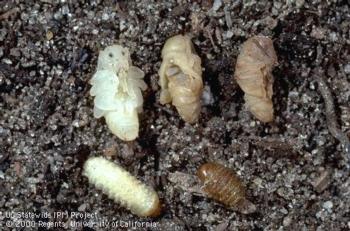
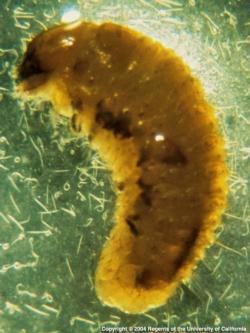
Fig. 6. In left-side photo (A), pupae (above) and larvae (below) of black vine weevil; the brown ones are infected with the parasitic nematodes, Steinernema feltiae. Photo: J.K. Clark. The right-side photo (B) shows a Diapres root weevil killed by entomopathogenic nematodes. Photo: R. Duncan, E. Grafton-Cardwell, and I. Jackson.
Whiteflies
Hymenopteran parasitoids. Whiteflies in the genera Trialeurodes and Bemisia can be controlled through releases of Encarsia formosa (fig. 9) and Eretmocerus eremicus. If mixed whitefly species are present, some commercial insectaries will combine parasitoid species on a single release card (e.g., Enermix). There are no commercially available parasitoids for the iris whitefly, so growers often resort to pesticides when this whitefly appears in any significant numbers.
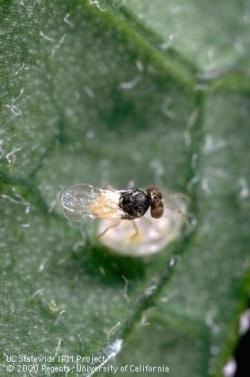
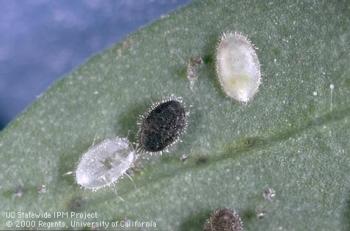
Fig. 8. In the left-side photo (A), Encarsia formosa is parasitizing a greenhouse whitefly nymph. The right-side photo (B) shows a greenhouse whitefly pupa (right), empty pupal case (left), and black pupa parasitized by Encarsia formosa (center). Black parasitized pupae are collected and glued onto cards that are commercially available; these cards are attached to plants for biological control. Photos: J.K. Clark
Predatory mites. The advent of the Amblyseius swirskii, which feeds on eggs and very early instars, is a promising addition to biological control in the greenhouse. Many growers make use of this predator to control both whiteflies and thrips. Although A. swirskii will also feed on spider mites, it has clear preference for the immature stages of whiteflies and thrips.
Entomopathogenic fungi. A mycoinsecticide containing spores of the fungus Beauveria bassiana has been developed commercially by BioWorks Inc. for control of whiteflies and other soft-bodied insects; one product is for use on conventional crops (BotaniGard) and another is approved for organic production (Mycotrol O). Isaria fumosoroseus is also available commercially (Certis USA) for control of whitefly and several other arthropods for greenhouse use. These microbial insecticide products can be applied to foliage with existing equipment used to apply any foliar pesticide. However, they are not compatible with chemical fungicides and are negatively impacted by several botanical products that have fungicidal activity. While efficacy can be very good, insect mortality will generally be slower than what would be expected from chemical pesticides, and adult whiteflies are not affected by these applications. These mycoinsecticide products are generally considered to be compatible with most natural enemies, although timing the release of natural enemies after spraying may be critical and is host-dependent.
Biological Control May Not Work on All Pests
Natural enemies are available for other pests but there is limited data supporting efficacy. Biological control of the broad mite is very difficult, although the use of predatory mites such as Amblyseius swirskii and Neoseiulus cucumeris may help control the pest. Early presence and damage from these mites is difficult to detect on floriculture crops, so growers often have little choice but to spray acaricides. Soil-dwelling predatory mites (Hypoaspis spp.) have been claimed to suppress or regulate bulb mite populations, and one study found that A. (=Neoseiulus) barkeri had potential to control bulb mites on amaryllis. However, there are no specific guidelines for how to use these predatory mites that are based on practical field trials.
There are also no effective biological control agents for mealybugs attacking ornamental crops in the greenhouse or nursery. Although the mealybug destroyer, Cryptolaemus montrouzieri is available commercially and is often recommended, adults are rarely recovered after release. However, the commercial availability of mealybug destroyer larvae may be the breakthrough that is needed for biological control of mealybugs. This predator, however, is not effective on long-tailed mealybug. C. montrouzieri requires cottony egg masses for egg-laying; long-tailed mealybugs do not have cottony egg masses.
Natural enemies for scale insects are commercially available, including lady beetles, larvae of green lacewings, and several parasitoids such as Aphytis melinus for California red scale and Metaphycus helvolus for brown soft scale and hemispherical scale. However, although these natural enemies are often recommended, biological control will not necessarily prevent significant scale infestations, and there are no published research studies to support their use in ornamental production.
Michael Parrella is Dean of the College of Agricultural and Life Sciences, University of Idaho and President of the Entomological Society of America; Ed Lewis is Department Head and Professor of Entomology, Plant Pathology, and Nematology, University of Idaho.
This article is adapted from the following publication: Parrella MP, Lewis E. 2017. Biological control in greenhouse and nursery production: Present status and future directions. American Entomologist, 63(4): 237-250. https://doi.org/10.1093/ae/tmx010. We thank the Entomological Society of America for permission to use this material. Please refer to the original article for more information about biological control and a list of references.
Table 1. Commercially available natural enemies of floriculture and nursery pests with evidence of efficacy.
|
Target Pests Effectively Controlled |
Natural Enemy Type |
Natural Enemy |
|
aphids |
Hymenopteran parasitoid entomopathogenic fungi (microbial pesticides) |
Aphidius colemani Beauveria bassiana, Isaria fumosoroseus |
|
caterpillar pests |
microbial pesticide |
Bacillus thuringiensis (Bt) (may be combined with parasitoids) |
|
fungus gnats
|
predatory mite entomopathogenic nematodes microbial pesticide |
Hypoaspis miles Steinernema feltiae Bacillus thuringiensis ssp. israelensis |
|
leafminers
|
Hymenopteran parasitoids |
Diglyphus isaea, Dacnusa sibirica |
|
spider mites |
predatory mites |
Metaseiulus occidentalis, Neoseiulus californicus, Phytoseiulus persimilis |
|
thrips |
Hymenopteran parasitoid predatory mites entomopathogenic nematode combined with predatory mites entomopathogenic fungus (microbial pesticide) |
Thripobius semiluteus (for greenhouse thrips) Amblyseius swirskii, Neoseiulus cucumeris, Hypoaspis miles Heterorhabditis spp. + predatory mites Beauveria bassiana (low populations) |
|
weevils |
entomopathogenic nematodes
entomopathogenic fungus (microbial pesticide) |
Heterorhabditis spp., Steinernema spp. Metarhizium anisopliae |
|
whiteflies |
Hymenopteran parasitoids Predatory mite entomopathogenic fungi (microbial pesticides) |
Encarsia formosa, Eretmocerus eremicus Amblyseius swirskii Beauveria bassiana, Isaria fumosoroseus |












